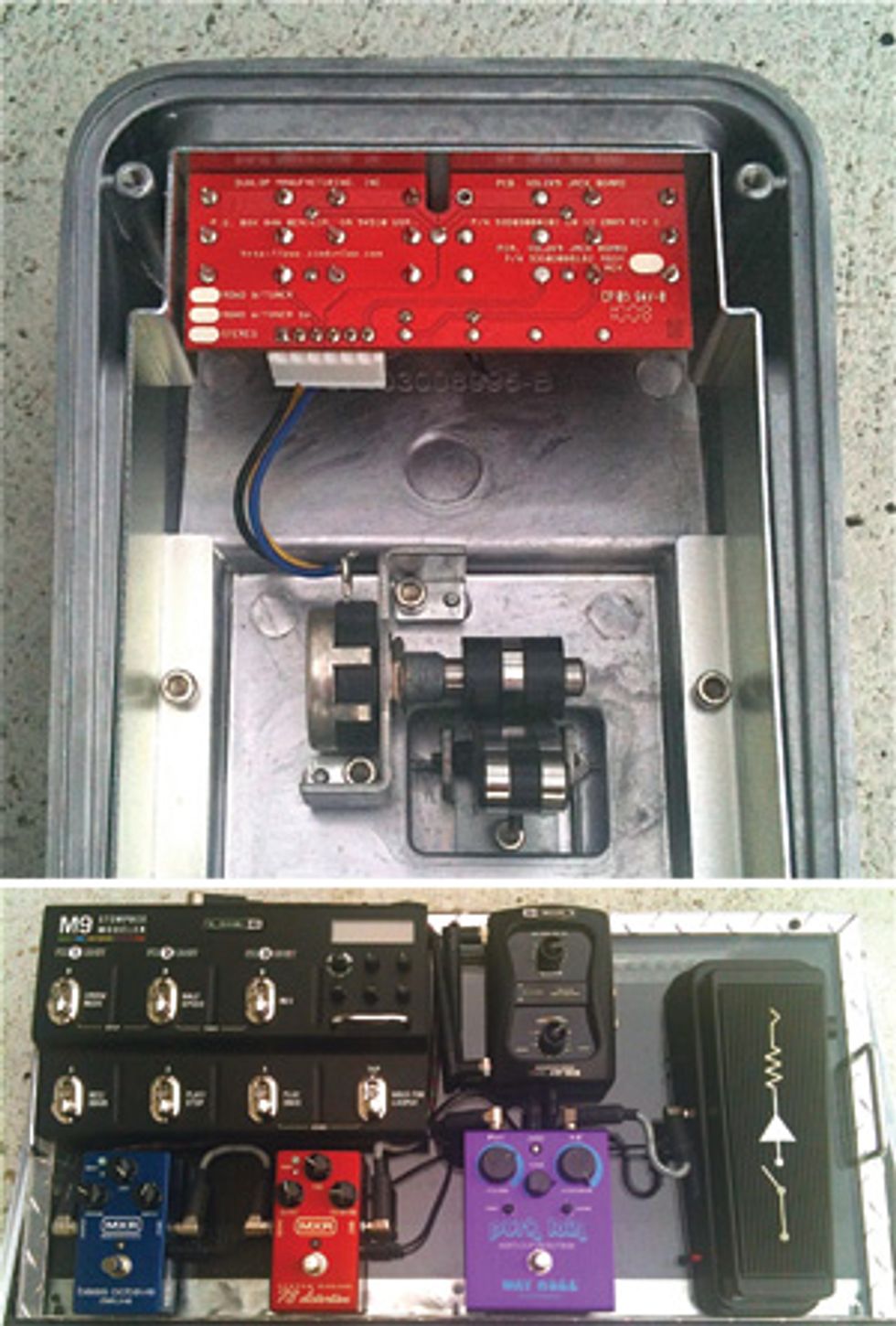
Top: A peek inside a Dunlop DVP1 volume pedal reveals a 250k pot that’s well suited for passive pickups and preserving high-end frequencies.
Bottom: Wiring job in progress. A Line 6 M9 stompbox modeler, Line 6 G50 wireless system, MXR Bass Octave Deluxe, MXR Custom Badass ’78 Distortion, Way Huge Pork Loin overdrive, and a Custom Audio Electronics MC404 wah mounted on a Trailer Trash pedalboard. When assembling a pedalboard, the key is to experiment with the arrangement of your stompboxes to optimize the signal flow for your playing style.
In last month’s column [“Recipes for Non-Guitar Sounds,” July 2012] we explored a number of ways to achieve some unique tones by using different objects and pedals with a guitar. This month, let’s examine the factors involved in getting the most out of your pedals and signal flow.
The first thing to understand is that there are many ways to configure your signal flow, and there’s no “correct” method for arranging your pedals. The only rule here: If you like the way it sounds, it’s right.
Volume Pedals
The first pedal that most people plug into
on their board is a volume pedal, so it’s
vital to consider the rating of the potentiometer
inside the pedal. Let’s take a look
at some of the differences between 500k
Ω, 250k Ω, and 25k Ω pots.
More susceptible to ambient noise than lower-rated pots, 500k pots provide a high end roll-off as the pedal moves toward the heel position. Some guitarists like to have their amps set really bright and use this high-end roll off to make the sound creamier and less abrasive.
Probably the most common pot installed on production volume pedals, the 250k pot has great dynamic range for almost all passive guitar pickups. The high end remains more intact than it does on a 500k pot when the pedal moves toward the heel position.
A 25k pot is a good choice if you have high-output active pickups. The high end is preserved with phenomenal fidelity when the pedal is moved toward the heel. Basically, as the pot rating becomes smaller, the preservation of the high end is better maintained. Because I don’t often use active pickups and I don’t like sacrificing high end, a 250k potentiometer is the best option for my needs.
Overdrives and Distortions
Bryan Kehoe, the “in-house guitar culture
representative of Dunlop effects,” makes an
interesting suggestion regarding the placement
of multiple overdrives and distortions
on a pedalboard.
“I arrange my fuzzes and distortions in a fashion so that the cleaner set of boosts and overdrives are placed later in the signal chain,” says Kehoe. “To me, this is the most logical way to stack up the gain-stage ladder. The reason I do this is that the distortions and fuzzes have a lot of saturation and square waves. If the heavily saturated pedals go after the cleaner set, the more saturated pedals will choke off the transparent overdrives, which I don’t prefer tone-wise.”
Delays
Since distortions and overdrives are often
paired with delay for lead playing, the placement
of the delay also needs to be considered.
Have you ever been playing a solo using
your amp’s lead channel with a delay pedal,
and you hear a grinding, clashing, dissonant
sound when you bend a string? If so, this
most likely happened because your delay was
in front of the amp’s input. The best way to
get around this problem is to run your delay
through the amp’s effects loop. Generally, the
reason you don’t want your delay before your
overdrive pedal (or your amp’s lead channel)
is that the repeats from the delay will
continue to cycle through the distortion with
each delay generation. This can quickly result
in a smeary-sounding sonic mess. When
you put your delay in the effects loop, it is
inserted after the preamp section of the amp
and before the power section.
Effects Loops
Tim McKee at Mesa/Boogie provides us with
a quick run-down on the differences between
parallel and series effects loops. “A parallel
effects loop is wired in parallel to the amp’s
dry signal,” explains McKee. “And it has a
mix level control allowing you to mix in the
amount of wet signal from your effects in relation
to the amp’s dry signal at the effects loop
return. This optimizes blending of effect levels
and the amp’s signal. This type of effects loop
works well with multi-effects processors that
have input and output level controls.”
“A series effects loop sends the amp’s signal from the amp’s preamp section out through the effects send,” continues McKee. “The signal is then fed back from the effects into the effects return. There is no mix level control (or potentiometer circuit) because all of the signal is fed through the send and comes back in the return. That said, both parallel and series effects loops interrupt the signal between the preamp and power-amp sections of the amplifier.”
It is key to have unity gain at the effects loop, which means that the level coming back into the amp at the effects return is consistent with the level that left through the effects send. If these levels are not the same, you may have issues like changes in volume when stepping on certain pedals, or considerable “thinning” of your overall tone. The best way to avoid this is to keep anything that boosts a signal—like overdrives and distortions—out of your effects loop and in front of the amp.
Personally, I prefer to have all my pedals in front of the amplifier. When you are assembling your rig, the best approach is to study how several players arrange their pedals and why. You’ll almost always pick up new tips and ideas from other players.














